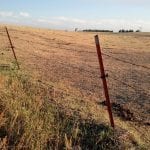Justin Waggoner, Ph.D., Beef Systems Specialist, Garden City
 Traditionally, when cowherd supplementation is discussed we focus on meeting the protein needs of the cow, with the goal of maximizing forage intake by supplementing protein, the most limiting nutrient in dormant native forages. However, drought often limits the supply of both grazed and harvested forages in many regions. In this scenario both energy and protein are limiting cow performance and therefore, supplements should be evaluated on both their energy and protein contributions to the nutrition program. When evaluating potential feedstuffs as supplements consider both the cost per unit of energy (TDN, net energy maintenance or metabolizable energy) and crude protein basis
Traditionally, when cowherd supplementation is discussed we focus on meeting the protein needs of the cow, with the goal of maximizing forage intake by supplementing protein, the most limiting nutrient in dormant native forages. However, drought often limits the supply of both grazed and harvested forages in many regions. In this scenario both energy and protein are limiting cow performance and therefore, supplements should be evaluated on both their energy and protein contributions to the nutrition program. When evaluating potential feedstuffs as supplements consider both the cost per unit of energy (TDN, net energy maintenance or metabolizable energy) and crude protein basis
The major concern regarding energy supplementation in a non-drought situation, when forage supply is adequate is the “substitution effect”; essentially the energy supplement (starch or grain-based) reduces grazed forage intake which compromises overall energy balance. Under non-drought conditions, fiber-based opposed to starch-based energy sources are recommended. However, in a drought situation when forage supply is critically low meeting the energy requirements of the cow using the most economical feedstuffs available (cost per unit of energy basis) is our first priority and the source of supplemental energy (fiber vs. starch) is of less concern.
If a commercially blended supplement is used (range cubes), consider the inclusion of an ionophore. The use of ionophores (Rumensin and Bovatec) is standard management practice in growing and finishing cattle diets. Rumensin is the only product approved for use in mature beef cows and must be delivered in at least 1.0 lbs of dry feed per day. Research conducted with cows indicates that cows fed 200 mg/d of monensin (Rumensin) required 5-10% less feed to maintain the same weight and body condition as cows that did not receive Rumensin.
During a drought situation, non-traditional grazing opportunities often present themselves. The high price of forages often makes baling look attractive. However, in almost every, if not every situation, grazing forages presents a lower cost alternative to haying. A number of different opportunities may be available (grazing re-growth in wheat stubble, failed corn, milo soybeans etc). However, some of these grazing opportunities carry risk (nitrates). If you have questions regarding any of these non-traditional grazing opportunities consult your local K-State Extension professional.
Consider locating mineral feeders or delivering supplements in under-utilized areas to encourage grazing behavior. Pastures should be evaluated frequently to assess available forage, and over-grazing should be avoided to minimize long-term effects on the pasture.
There is no easy way to manage cattle through a drought. Some of the key elements to successfully managing cattle through a drought is managing head/days, evaluating both short and long term outcomes associated with decisions and not being afraid to think outside the box, because thankfully drought is not the norm and resides outsides the box.